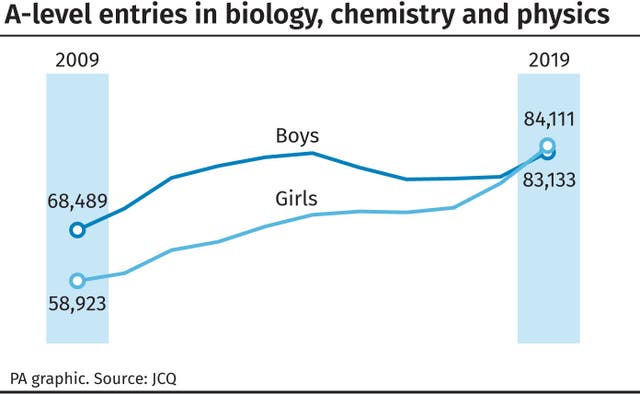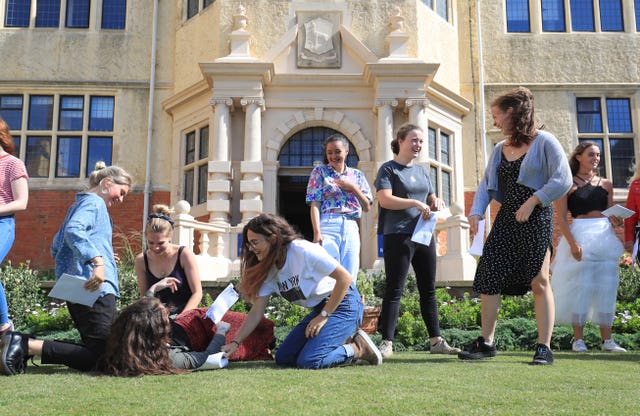
Girls have overtaken boys in A-level science entries for the first time, national figures show.
The gender switch was hailed as “a cause for celebration” by scientists as school leaders suggested that an increase in female role models in the subjects may be contributing to the trend.
The figures came in national A-level results, published today, which showed that across all subjects, the proportion of A-level entries awarded an A grade or higher has fallen to the lowest level for more than a decade.
Girls narrowly clawed back the lead from boys in terms of overall A* and A grades, although boys still outperformed their female classmates in the highest result.
And Spanish has become the most popular foreign language at A-level, overtaking French for the first time.
The figures, published by the Joint Council for Qualifications (JCQ), cover A-level entries from students in England, Wales and Northern Ireland.
Around 300,000 students are receiving their results today.

A key change was the shift in entries for A-levels in the three sciences – biology, chemistry and physics.
For all three subjects combined, there were 84,111 entries from girls this year, compared with 83,133 from boys, according to an analysis of data published by the JCQ.
The change has been driven by more girls than boys taking biology and chemistry.
Boys are still significantly more likely to take physics, with more than three times as many entries than their female counterparts (30,159 compared with 8,799).

Professor Tom McLeish, chairman of the Royal Society education committee said it was “delighted that the sciences are faring positively” with overall increases in entries for science subjects.
He added: “A further cause for celebration is that female entries in the sciences are at a historic high, with increasing numbers of girls opting for chemistry and physics.
“However, there is still work to do in closing the gender-gap in maths and computing.”
Well done to everyone receiving their A level results today – a fantastic achievement after two years of hard work and dedication. #alevelresults2019
— Boris Johnson (@BorisJohnson) August 15, 2019
Geoff Barton, general secretary of the Association of School and College Leaders (ASCL), said this year was a “milestone” in science entries.
“There’s been a trajectory and this is the year that is a milestone in which we’re seeing females saying ‘this is as much my territory as it is male territory’,” he said.
He added: “As a head you were always looking to try and appoint a female physics or chemistry teacher in particular because you knew how that would resonate, and you would bring back students who had gone to university and studied chemistry so that females were seeing that.”
John Cope, CBI head of education and skills policy, said: “Historically as a country we have failed to close the gap between boys and girls taking science.
“Firms will be delighted to see that gap close, with more girls taking up science subjects and performing well.”

In total, 25.5% of UK entries were awarded an A or A* grade this summer, the lowest proportion since 2007 when it was 25.3%.
A* grades were introduced in 2010. Before this, the highest result was an A.
Girls are back on top in terms of top grades, with 25.5% of entries handed at least an A, compared with 25.4% of boys – a gap of 0.1 percentage points.
But on A* grades alone, boys performed better, with 8.2% of entries getting the highest result, compared with 7.5% of girls’ entries.
In languages, Spanish is now the most popular foreign language A-level, with 8,625 entries compared to 8,355 for French.
French has seen a decline in recent years, while Spanish has been increasing in popularity.


Comments: Our rules
We want our comments to be a lively and valuable part of our community - a place where readers can debate and engage with the most important local issues. The ability to comment on our stories is a privilege, not a right, however, and that privilege may be withdrawn if it is abused or misused.
Please report any comments that break our rules.
Read the rules here